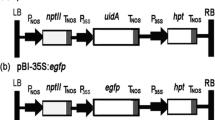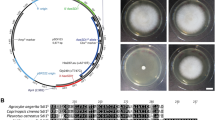Abstract
Application of biotechnology to the cultivated mushroom,Agaricus bisporus, has been hampered thus far by the lack of a transformation system. Here, transformation of both a homo- and a heterokaryotic strain ofA. bisporus to hygromycin B resistance is described. Transforming DNA was integrated into theA. bisporus genome and stably maintained throughout vegetative growth. Transformants of the heterokaryotic strain formed transgenic fruiting bodies. Promoters derived from the unrelated ascomyceteAspergillus nidulans and fromA. bisporus itself, were able to drive expression of the hygromycin B resistance gene. Expression controlled by a fragment of 265 bp from theA. bisporus GPD promoter was sufficient to generate transformants. However, transformation efficiency was not enhanced by using this homologous promoter.
Similar content being viewed by others
References
Barrett V, Dixon RK, Lemke PA (1990) Genetic transformation of a mycorrhizal fungus. Appl Microbiol Biotechnol 33:313–316
Casselton LA, de la Fuente Herce A (1989) Heterologous gene expression in the basidiomycete fungusCoprinus cinereus. Curr Genet 16:35–40
Castle AJ, Horgen PA, Anderson JB (1987) Restriction fragment length polymorphisms in the mushroomsAgaricus brunnescens andAgaricus bitorquis. Appl Environ Microbiol 53:816–822
Challen MP, Elliott TJ (1994) Evaluation of the 5-fluoroindole resistance marker for mushroom transformation. Cultivated Mushroom Res Newslett 2:13–20
Challen MP, Rao BG, Elliott TJ (1991) Transformation strategies forAgaricus. In: Van Griensven LJLD (ed) Genetics and breeding ofAgaricus. Pudoc Wageningen, pp 129–134
Chang ST, Miles PG (1991) Recent trends in world production of cultivated mushrooms. Mushroom J 503:15–18
Fincham JRS (1989) Transformation in fungi. Microbiol Rev 53:148–170
Gamborg OL, Miller RA, Ojima K (1968) Nutrient requirements of suspension cultures of soybean root cells. Exp Cell Res 50:151–158
Gritz L, Davies J (1983) Plasmid-encoded hygromycin B resistance: the sequence of hygromycin B phosphotransferase gene and its expression inEscherichia coli andSaccharomyces cerevisiae. Gene 25:179–188
Harmsen MC, Schuren FHJ, Moukha SM, Van Zuilen CM, Punt PJ, Wessels JGH (1992) Sequence analysis of the glyceraldehyde-3-phosphate dehydrogenase genes from the basidiomycetesSchizophyllum commune, Phanerochaete chrysosporium andAgaricus bisporus. Curr Genet 22:447–454
Horgen PA, Jin T, Anderson JB (1991) The use of protoplast production, protoplast regeneration and restriction fragment length polymorphisms in developing a systematic and highly reproducible breeding strategy forAgaricus bisporus. In: Van Griensven LJLD (ed) Genetics and breeding ofAgaricus. Pudoc Wageningen, pp 62–72
Judelson HS (1993) Intermolecular ligation mediates efficient cotransformation inPhytophthora infestans. Mol Gen Genet 239:241–250
Kumagai MH, Donson J, Della-Cioppa G, Harvey D, Hanley K, Grill LK (1995) Cytoplasmic inhibition of carotenoid biosynthesis with virus-derived RNA. Proc Natl Acad Sci USA 92:1679–1683
Li A, Horgen PA (1993) Attempts to develop a transformation system inAgaricus bisporus, utilizing particle bombardment and several other novel approaches. Cultivated Mushroom Res Newslett 1:11–16
Li A, Begin M, Kokurewicz K, Bowden C, Horgen PA (1994) Inheritance of strain instability (sectoring) in the commercial button mushroom,Agaricus bisporus. Appl Environ Microbiol 60:2384–2388
Marmeisse R, Gay G, Debaud J-C, Casselton LA (1992) Genetic transformation of the symbiotic basidiomycete fungusHebeloma cylindrosporum. Curr Genet 22:41–45
Mattern IE, Punt PJ, van den Hondel CAMJJ (1988) A vector ofAspergillus transformation conferring phleomycin resistance. Fungal Genet Newslett 35:25
Mooibroek H, Kuipers AGJ, Sietsma JH, Punt PJ, Wessels JGH (1990) Introduction of hygromycin B resistance intoSchizophyllum commune: preferential methylation of donor DNA. Mol Gen Genet 222:41–48
Mullaney EJ, Hamer JE, Roberti KA, Yelton MM, Timberlake WE (1985) Primary structure of thetrpC gene fromAspergillus nidulans. Mol Gen Genet 199:37–45
Murashige T, Skoog F (1962) A revised medium for rapid growth and bioassays with tobacco tissue cultures. Physiol Plant 15:473–497
Noël T, Labarère J (1994) Homologous transformation of the edible basidiomyceteAgrocybe aegerita with theURA1 gene: characterization of integrative events and of rearranged free plasmids in transformants. Curr Genet 25:432–437
Peng M, Singh NK, Lemke PA (1992) Recovery of recombinant plasmids fromPleurotus ostreatus transformants. Curr Genet 22:53–59
Punt PJ, Oliver RP, Dingemanse MA, Pouwels PH, Van den Hondel CAMJJ (1987) Transformation ofAspergillus based on the hygromycin B resistance marker fromEscherichia coli. Gene 56:117–124
Raeder U, Broda P (1985) Rapid preparation of DNA from filamentous fungi. Lett Appl Microbiol 1:17–20
Randall T, Reddy CA, Boominathan K (1991) A novel extrachromosomally maintained transformation vector for the lignindegrading basidiomycetePhanerochaete chrysosporium. J Bact 173:776–782
Raper JR, Raper CA (1972) Life cycle and prospects for interstrain breeding inAgaricus bisporus. Mushroom Sci 8:1–9
Royer JC, Horgen PA (1991) Towards a transformation system forAgaricus bisporus. In: Van Griensven LJLD (ed) Genetics and breeding ofAgaricus. Pudoc Wageningen, pp 135–139
Sambrook J, Fritsch EF, Maniatis T (1989) Molecular cloning: a laboratory manual (2nd edn) Cold Spring Harbor Laboratory Press, Cold Spring Harbor, New York
San Antonio JP (1971) A laboratory method to obtain fruit from cased grain spawn of the cultivated mushroom,Agaricus bisporus. Mycologia 63:16–21
Schiestl RH, Petes TD (1991) Integration of DNA fragments by illegitimate recombination inSaccharomyces cerevisiae. Proc Natl Acad Sci USA 88:7585–7589
Schuren FHJ, Wessels JGH (1940) Highly-efficient transformation of the homobasidiomyceteSchizophyllum commune to phleomycin resistance. Curr Genet 26:179–183
Sonnenberg AS, Wessels JG, Van Griensven LJ (1988) An efficient protoplasting/regeneration system forAgaricus bisporus andAgaricus bitorquis. Curr Microbiol 17:285–291
Summerbell RC, Castle AJ, Horgen PA, Anderson JB (1989) Inheritance of restriction fragment length polymorphisms inAgaricus brunnescens. Genetics 123:293–300
Van Tunen AJ, Koes RE, Spelt CE, Van der Krol AR, Stuitje AR, Mol JNM (1988) Cloning of the two chalcone flavanone isomerase genes fromPetunia hybrida; coordinated, light-regulated and differential expression of flavonoid genes. EMBO J 7:1257–1263
Author information
Authors and Affiliations
Additional information
Communicated by C. A. M. J. J. van den Hondel
Rights and permissions
About this article
Cite this article
van de Rhee, M.D., Graça, P.M.A., Huizing, H.J. et al. Transformation of the cultivated mushroom,Agaricus bisporus, to hygromycin B resistance. Molec. Gen. Genet. 250, 252–258 (1996). https://doi.org/10.1007/BF02174382
Received:
Accepted:
Issue Date:
DOI: https://doi.org/10.1007/BF02174382




